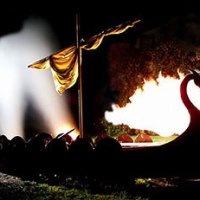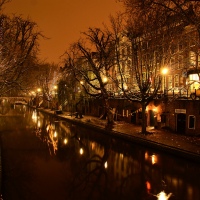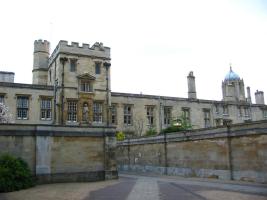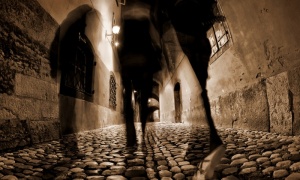Welcome, dear readers, to the fascinating world of British folklore, myth, and legend! Today, we are going to explore the mysterious Whispering Knights, King’s Men, and Rollright Stones and try to uncover the truth behind their eerie presence.
Now, these ancient stone formations are located in the idyllic Cotswolds countryside of England and are said to date back to the Bronze Age. According to popular belief, they were once a group of soldiers turned to stone by a sorcerer for their misdeeds.
Legend has it that if you visit the stones at night, you can hear the whispers of the petrified knights, plotting their revenge against the sorcerer who cursed them. Spooky stuff, right?
But let’s take a step back and look at the actual history of these stones. Archaeologists believe that they were actually erected over several centuries, starting around 2500 BC, as part of a burial site. The Rollright Stones themselves are made up of three separate groups: the Whispering Knights, King’s Men, and the King Stone.
The Whispering Knights are a group of four upright stones that are said to resemble a group of knights huddled together in a conspiratorial whisper. The King’s Men are a circle of seventy-seven stones, while the King Stone is a single standing stone that was possibly used for ritualistic purposes.
While the exact reason for their construction remains a mystery, one thing is for sure – the Rollright Stones have captured the imaginations of people for thousands of years. They have been the subject of countless myths and legends, inspiring everything from poetry to modern-day witchcraft.
So, what is the true story behind the Whispering Knights, King’s Men, and Rollright Stones? The answer, my friends, is shrouded in the mists of time. Perhaps they were indeed a group of cursed knights, turned to stone for their wickedness. Or maybe they were simply erected by ancient people as a way of marking their dead.
Either way, we can all agree that the Rollright Stones are a fascinating glimpse into Britain’s rich history and should be on everyone’s bucket list of places to visit. Just don’t go there at night, unless you want to risk hearing the whispers of the cursed knights!
Until next time, stay curious and keep exploring the strange and mysterious world around us.
Read on for more…
The lost traveller stumbled through the dark woods, his feet sinking into the damp earth with each step. He had heard tales of the Rollright Stones, and his curiosity had gotten the better of him.
As he approached the ancient stone formation, he felt a chill run down his spine. The stones loomed large in the darkness, casting eerie shadows on the ground. He took a step forward, and the ground seemed to tremble beneath his feet.
Suddenly, he heard a low whisper, almost too soft to hear. He turned around, but there was no one there. He took another step, and the whisper grew louder, more insistent. He looked up at the stones and saw four figures standing together, as if in conversation.
As he drew closer, the figures seemed to come to life, their stone bodies shimmering in the moonlight. The traveller stumbled back in terror, his heart pounding in his chest.
The whispers grew louder, and the traveller realized they were coming from the petrified knights. They were plotting something, he was sure of it. But what could it be? He strained to listen, but the words were garbled, as if spoken in a language he couldn’t understand.
Suddenly, the wind picked up, and the trees rustled ominously. The traveller felt a cold breeze on his face, and he knew he had to get out of there. He turned to run, but his feet were rooted to the ground.
He closed his eyes and braced himself for the worst. But when he opened them again, the knights were gone, and he was standing alone in the darkness.
As he stumbled away from the Rollright Stones, he knew he had experienced something beyond the realm of explanation. The whispers of the knights still echoed in his mind, haunting him long after he had left the ancient stones behind.
The Rollright Stones, a complex of standing stones in Oxfordshire, England, has long been the subject of mystery and legend. Of particular interest are the three distinct groups of stones known as the Whispering Knights, King’s Men, and King Stone. Despite their fame, the true origins and purpose of these stones have been the subject of debate for centuries.
The Whispering Knights are a group of four upright stones, positioned in a huddle as if in conversation. According to local folklore, they were once four knights who conspired against their king and were turned to stone as punishment. The truth behind this legend is likely lost to time, but it is believed that the stones were erected during the late Neolithic or early Bronze Age, around 3000 to 2000 BCE.
The King’s Men, a circle of seventy-seven stones, is the largest group within the Rollright Stones complex. Local legend suggests that the stones represent soldiers who fought and died in a great battle, although there is no historical evidence to support this claim. The stones were likely erected during the same time period as the Whispering Knights, and their purpose remains a mystery.
The King Stone, the third group of stones, is a single standing stone that towers over the landscape at a height of nine feet. It is believed that the King Stone was erected during the early Bronze Age, around 2000 to 1500 BCE. Local folklore suggests that the stone has healing powers, and it has been the site of numerous rituals and ceremonies throughout history.
Despite the lack of concrete evidence, there are many theories as to the purpose and meaning behind the Rollright Stones. Some believe that they were used as a site for astronomical observation, while others suggest that they were a place of worship or a burial site. There are also those who believe that the stones were erected for their own sake, as a symbol of power or prestige.
The theory that the Rollright Stones were used for astronomical observation is based on the alignment of the King Stone with the midsummer sunrise. It is possible that the ancient people who erected the stones had an advanced understanding of astronomy and used the stones as a way to mark the changing of the seasons. This theory is supported by the fact that many other standing stone circles across the British Isles have been found to be aligned with astronomical events.
Others have suggested that the Rollright Stones were used as a place of worship or a burial site. The stones may have held spiritual significance for the people who erected them, and they may have been used for rituals and ceremonies. This theory is supported by the fact that many ancient cultures across the world have used standing stones as part of their religious practices.
Finally, some believe that the Rollright Stones were erected for their own sake, as a symbol of power or prestige. The stones may have been a way for ancient people to assert their dominance over the landscape, or to mark their territory. This theory is supported by the fact that many ancient cultures have built monuments and structures as a way to demonstrate their power and influence.
While we may never know the true purpose and meaning behind the Rollright Stones, they continue to capture the imagination of people today. Their mysterious origins and enduring legacy remind us of the deep connection between humans and the natural world, and the power of the human spirit to create something lasting and meaningful.

















Leave a comment